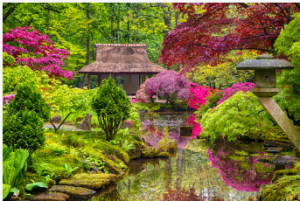Garden design can be a rewarding and creative career. You’ll create spaces that bring joy and interest to your property for years.
Garden designers possess a particular combination of creative imagination and objectivity. As a result, they can make difficult decisions for the benefit of both their clients and gardens, which helps ensure success in any endeavour.
 Designing the Garden
Designing the Garden
Crafting the ideal design is an integral step in the garden-making process. Your aim should be to create an attractive space that provides all the functions and pleasures you desire.
A well-designed garden can express your style, the architecture of your house, and its surrounding landscape. It may even add to the overall appeal of the property.
When designing a garden, the first step is deciding how it will be utilised. For example, is it for relaxation with somewhere to sit and take the view? Or do you envision cultivating productive vegetables or herbs there? Additionally, children may require access to play equipment in your outdoor play area.
Create a Garden Designer SA plan that includes all of your desired elements. It could include pathways, patios or pergolas, fences, steps and other hardscape features. It could also have seating areas, garden rooms and orangeries for additional enjoyment.
Your plan should ideally be drawn on graph paper so it is as close to scale as possible. It is easy to achieve with a tape measure, graph paper and an ordinary pencil.
Once the map is drawn, you can begin filling it in with plant combinations that naturally grow together. When planting trees, shrubs or evergreens, be mindful of how far they will spread as you work.
When selecting flowering plants, choose a mix of bulbs, annuals and perennials that provide colour and blooms throughout the year. To add visual interest, pick plants with contrasting leaves and flowers – depending on the season, you can incorporate warm and cool hues in your arrangement.
When planting plants, consider their height, spread, and any foliage they may have. Tall-growing flowers look best at the back of a bed or in an island garden, while low-growing varieties look lovely at the front.
When designing the garden, consider where the afternoon sun will hit it. Gardens that receive direct sunlight tend to get hot and dry, making them difficult to maintain.
Planning the Layout
Planning the layout of your garden is vital if you want to maximise its potential. It allows you to consider its overall shape and scale and where elements like water features or plant-filled beds will go.
Start by drawing a scale map using a tape measure and graph paper. It is an easy step that will let you see the spaces available for your garden design. After creating the map, note any existing structures like fences or walls that will remain so you can refer back to them later.
Make a wish list of the items you would like to include in your garden, from simple water features to an extensive vegetable garden. Doing this will give you an idea of the overall aesthetic you wish to achieve and allow for planning specifics before beginning construction on any hardscape elements.
Hiring a Garden Designer SA is always an option if you’re uncertain about the layout or need assistance getting started. They have professional training and connections to local contractors who can guide you through terracing or grading issues.
If you’re new to gardening, start with one raised bed before progressing to more intricate designs and layouts. Over time, as your gardening knowledge grows, you can gradually expand your garden until it reaches its full potential.
Planting the Garden
Gardens can be a wonderful place to grow delicious meals for yourself and your family, but maintaining them requires plenty of work. That is why planning when planting is so important.
Before planting your garden, it’s essential to determine its hardiness zone and soil type. Many plants only thrive in certain areas, so research your plant’s hardiness zone before purchasing seeds or starting your planting venture.
Regularly inspect your garden for plant damage or disease and take immediate corrective action. You can do this by checking the undersides of leaves, pulling weeds and spraying with insecticidal soap or a water-soluble herbicide as necessary.